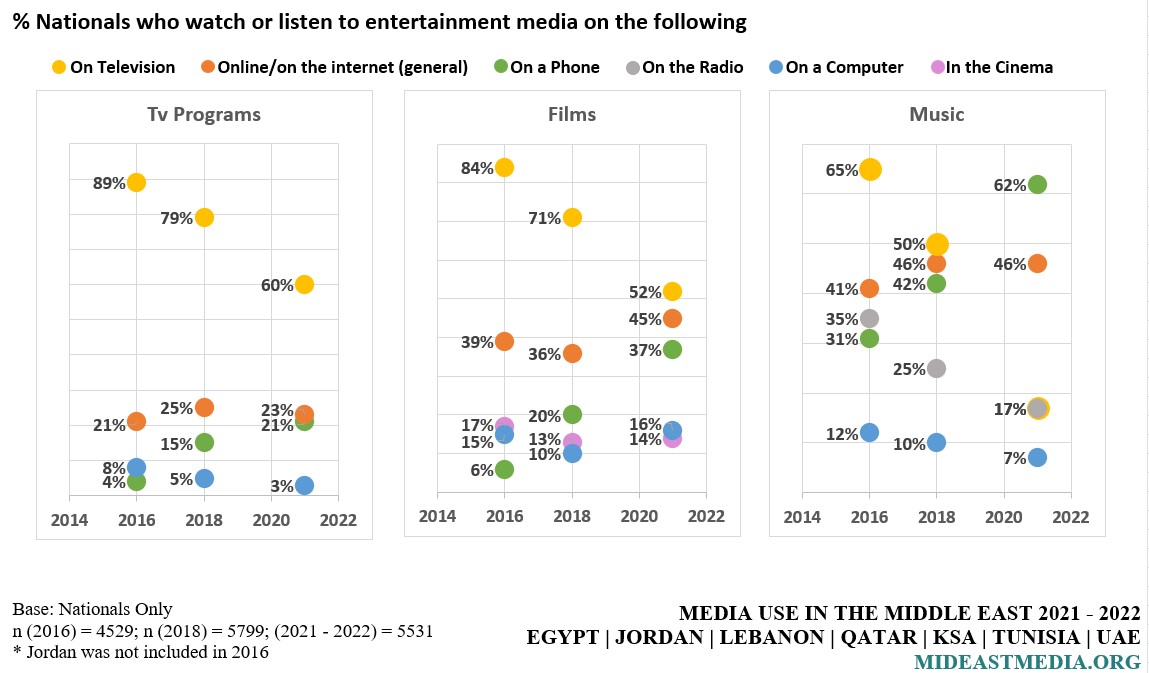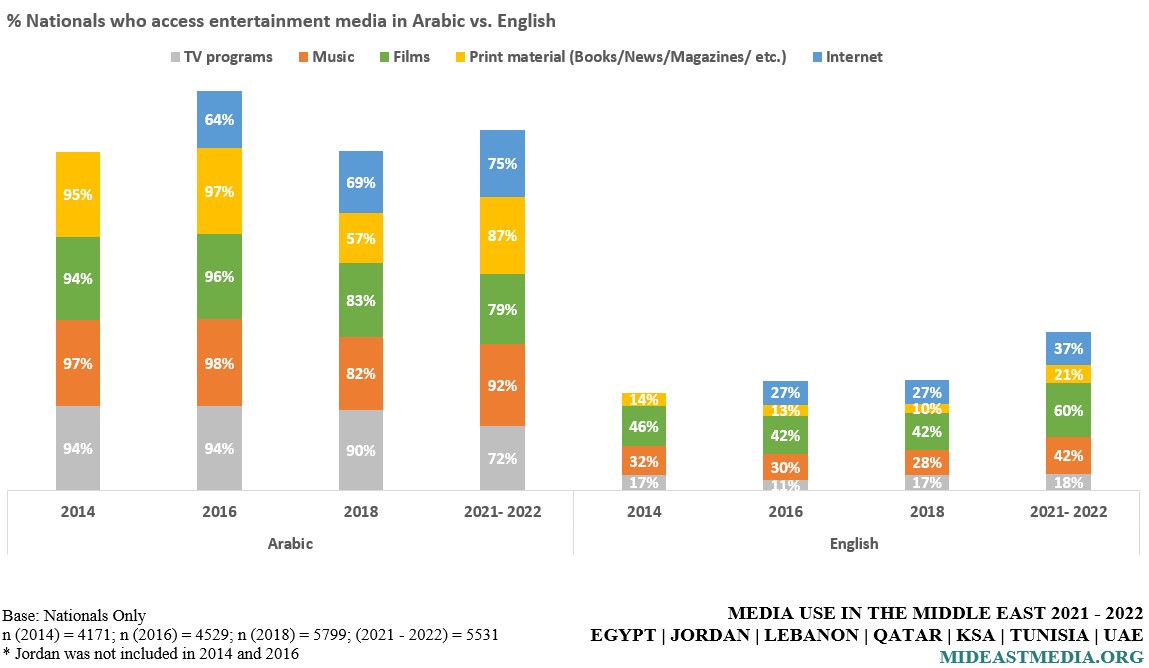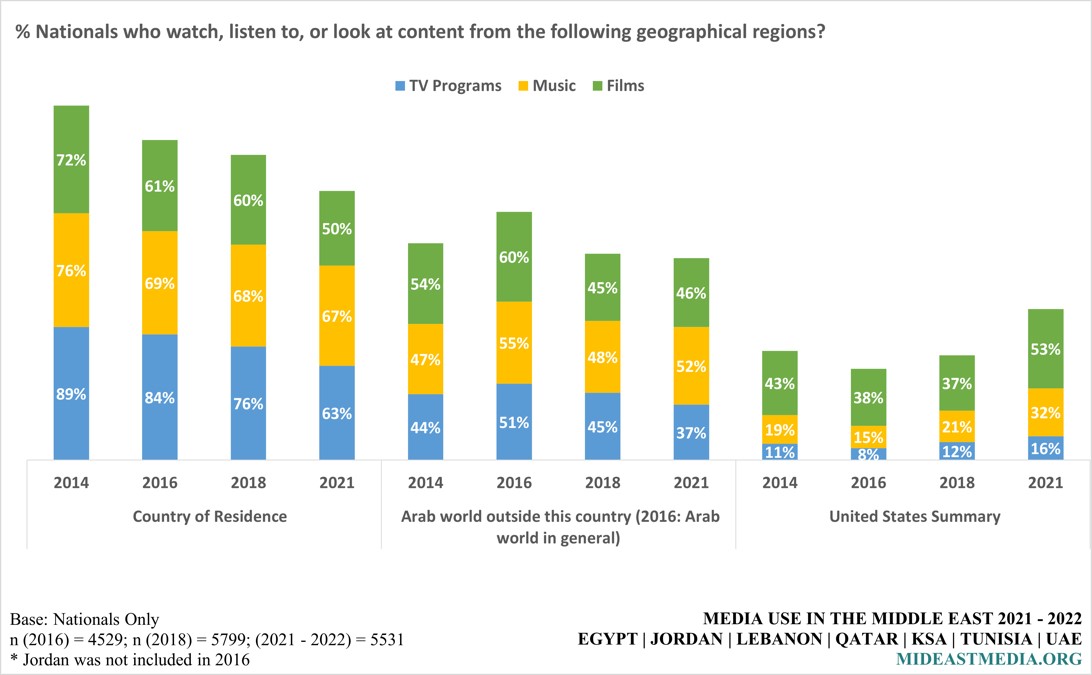As this decade-long longitudinal study comes to its end, this technical report includes an additional chapter on the most salient trends that we observed over the almost 10 years of the Media Use in the Middle East project, in the hope they highlight noteworthy shifts and transformation that have affected the Arab Region over this time-period.
Watching television has been the reigning as the activity most nationals do for fun/ leisure across all four iterations of the study (2014, 2016, 2016, 1018), and cinema-going is the least (almost 80% of nationals in 2021-2022 watch television and almost 2 in 5 nationals in the region watch films in the cinema. The percentage of nationals who report doing each of the mentioned activities for fun/leisure at all is far greater than those who do said activity on a daily basis.
Figure 39: Mediums Used over the Years to Access Entertainment Media

- Cinema going has been relatively the same in all the iterations of the study.
- The percentage of nationals who play video games has remained relatively the same across the years, with a slight increase in the latest iteration of the study,
- Newspaper readership has slightly decreased with the largest decrease recorded in the last iteration of the study.
- Radio listening rates have been declining since 2016.
- Playing and practicing sports witnessed a slight drop in 2018, followed by an increase in the latest year.
- Checking news online and watching films online increased across the years.
- Listening to music online has been stable across the years with a notable drop in 2018.
- Watching television on tv has been the reigning activity across the yeas although it has dropped in the region in the latest version of the study
There has been an increasing trajectory in the percentage of people using the internet in the past decade. In 2021-2022 almost all nationals in the region have accessed the internet and only 3% do not.
Mobility has been on a rising trajectory with smartphone ownership rising reaching 95%. With the exception of Tunisia where a good majority has access to smartphones, almost all nationals in each of the other six countries have access to a smartphone.
Figure 40: Languages Used Over the Years to Access Entertainment Media

- Arabic is the dominant language in accessing all forms of media in the region.
- Almost all nationals have read print material in Arabic in 2016 and 2014. This dominance has witnessed a drop in 2018 and increased again in 2021-2022
- Arabic has been the dominant language in watching films in 2014 and 2016 but has been witnessing a decrease since 2018.
- Despite the slight decrease in listening to music in Arabic in 2018, a strong majority listen to music in Arabic.
- Arabic has been the dominant language in watching tv programs but started dropping since 2018 followed by a slight increase in 2021/2022.
- Music is the media form most nationals’ access in Arabic in 2021-2022 and films are the most media forms accessed in English
Figure 41: Geographical Origins of Entertainment Media Consumed Over the Years

Entertainment content consumed in the region is primarily local, followed by regional content with a slow increase in the consumption of US content, which can be explained by the increasing internet penetration rate (97% in 2021-2022) and the rise of media consumption in English.
We noted a spike in 2016 of media consumed from the Arab World. That can be explained by the phrasing of the question that did not distinguish between country of residence and Arab world.
Figure 42: Attitudes on Freedom of Speech Over the Years

Support for censorship has been declining. Despite the fluctuation over the decade, we note that in 2021-2022, more nationals were tolerant to show media in its entirety in case of offensive content (58%) as opposed to those who called for banning such media content (46%). This can potentially be explained by the perception of media’s impact on morality. Local and regional entertainment content continues to be perceived predominantly as good for morality despite the decline (45% and 34% respectively in 2021-2022), while western entertainment content is still predominantly viewed as harmful for morality, despite the slow decline (39% Nationals perceive European media as harmful for morality and 37% nationals perceive American media as harmful for morality).